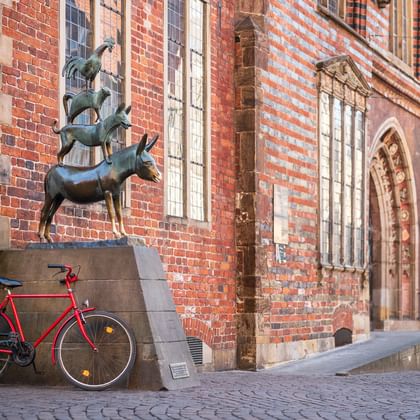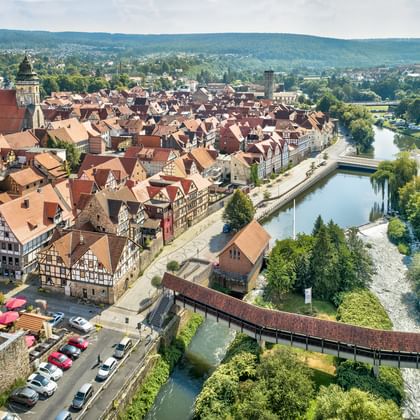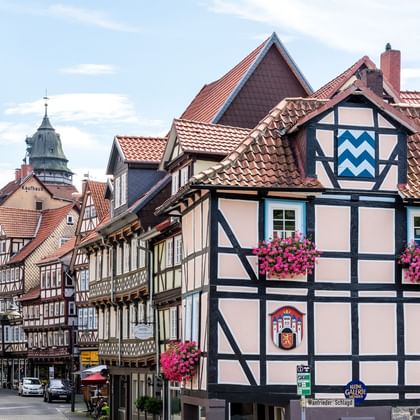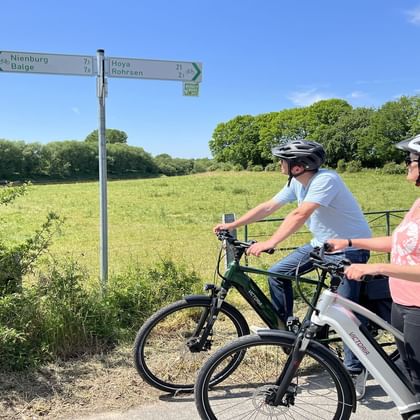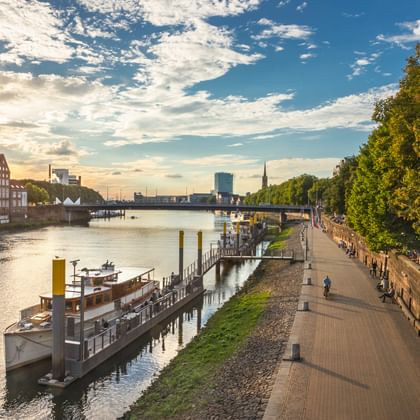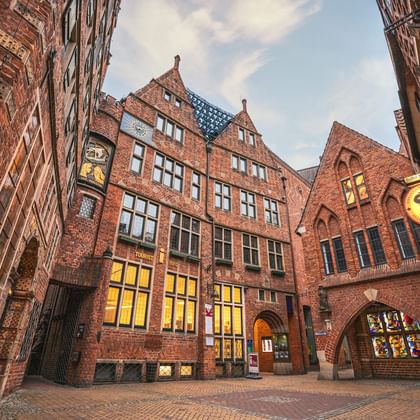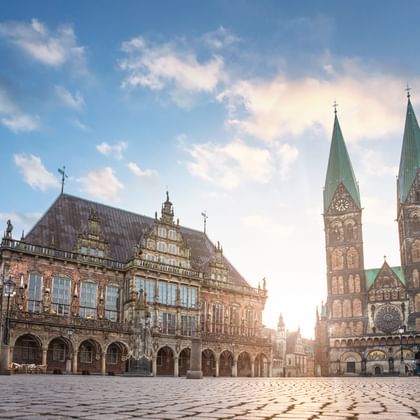Tour
We recommend bringing enough time to visit the city hall from the Weser Renaissance and the more than 700 half-timbered houses of the town.
Onto the bicycles! The former Benedictine monastery Bursfelde is the first sight waiting to be visited. Next on your list are the worthwhile open-air museum with its numerous mills and Bad Karlshafen.
The periphery of the Solling, Northern Germany’s second largest continuous wood-covered surface, will accompany you today! Fürstenberg castle, known world-wide for its chinaware manufacture, lies on your way to Corvey castle. After a short visit, you will follow your route to Bevern castle, one of the Weser Renaissance’s most impressive buildings. Allow yourself to take a break in Bodenwerder, home of the famous Baron Münchhausen, before the medieval atmosphere captures you in the Pied Piper’s town Hamelin.
Leaving beautiful Hameln means discovering other new places. Visit the town of Rinteln, it also has a lot to offer: The magnificent Old-Town from the Weser Renaissance, the ancient harbor and the historical steam railway. Bad Oeynhausen is North-Rhine Westphalia’s only national spa. It attracts the numerous visitors with its 36°C warm "Jordansprudel" – the world’s greatest sparkling thermal spring shooting up to 42 metres of height from 720 metres below the earth by itself. The valley gets a little narrower nearby Porta Westfalica, where the Weser and the numerous cyclists have to push their way through the Wiehen- and Weser mountains. A number of interesting museums (coffee museum, Prussian museum, button museum, doll museum) and nice cafes wait in Minden, so that the last few kilometres will be accomplished easily.
From today on, the landscape will be different: You enter the North German lowlands. Discover the Old-town of Nienburg on a special way: All you have to do is follow the bear-track leading you to the historical sights! Afterwards, small villages with brick-colored houses seam your way to Hoya.
You will reach today’s first stop in short time: the horsemen’s town Verden. A wide panorama, meadows like green carpets, wind mills and farms scattered here and there invite to take many pictures along the route. Past a stork haven you get closer and closer to Bremen. If you are lucky, the Town Musicians of Bremen already greet you from the distance, but you should in every case make a stop in front of the bronze statue at the city hall.
Today your beautiful Weser trip ends in Bremen after breakfast at the hotel. You can simply leave your rental bikes at the hotel and set off on your journey home without a care in the world. If you would like to return to your starting hotel in Hann. Münden, we recommend our practical return transfer service including bike transport.
Map
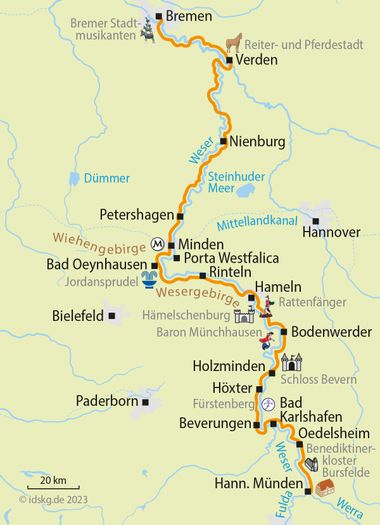
Prices / Dates
Services/Infos
- Accommodation incl. breakfast:
Category A: Comfortable middle-class hotels, mostly in the center
Category B: partly family-run inns and smaller hotels - Room with shower/bath/WC
- Luggage transport
- Digital route guidance via smartphone app
- Tips for tour preparation
- Touristic information
- 7 days hotline service
Worth knowing about the bike tour Weser: sportive till Bremen
Below you will find specific and helpful information. If you have further questions about this trip, you simply call us: Phone: +49 (0)6421 – 886890.
Arrival by train
Hann.Münden is easily accessible from all major cities in Germany by train. We recommend to take a taxi from the train station to get to our partner hotels in Hann. Münden. Current schedule information and price information can be found at: www.bahn.de.
Parking facilities at the arrival location
Our partner hotels in Hann.Münden have only a limited number of parking spaces. You can park your car for the duration of the trip in the car park at the “Tanzwerder”. Detailed information on parking at your hotel, you will receive by mail together with the detailed travel documents two weeks prior to departure.
Condition of cycle paths
The Weser bike trail is one of the best cycle routes in Europe. In surveys conducted by the Allgemeiner Deutscher fahrrad-Club (ADfC - General German Cycling Club), the Weser cycle path has become the most popular cycling route in Germany! Most of the time the bike trail runs parallel to the Weser waterway: especially between Hann.Münden and Rinteln it makes the special charm of this bicycle route. Large sections of the Weser bike track are well developed, paved bike trails, farm roads, or at least roads with separate routing paths. Occasionally short sections lead over country roads with less traffic. There are hardly any sections where you have to drive on unsurfaced roads. Often there are bike trails along both the banks of the Weser River. Especially between Hann.Münden and Werder you can pick the site and take the ferry to switch banks. However, the official Weserradweg bike route leads only on one side of the river.
Transfer back to the starting point of the journey
Daily at 3pm there is the possibility to transfer back to Hann.Münden with a small bus (with bike trailer). The driver comes to pick you up at your hotel and has much room for you, your luggage and where required your own bicycle. The bus takes you back to your first hotel (arrival approx. 6pm), thus ensuring a perfect return service without transfer and the hassle of hauling luggage. If you bring your own bicycles, an additional will be charged.
Extra costs which are not included in the price
Any tourist tax and charging fees for bicycle batteries are not included in the tour price and must therefore be paid at the hotel.
7 days hotline service
Just in case the bike chain is broken, flooding makes it impossible to continue your tour or any other nasty surprise: you can reach us seven days a week and we will do anything to help you as fast as possible.
Passport and visa requirements
For EU citizens, there are no special passport or visa requirements and no health formalities to be considered for this trip.
Travel insurance
The tour price already includes the statutory insolvency insurance. In addition, we recommend that you take out travel cancellation insurance upon receipt of your travel confirmation in order to protect yourself against financial disadvantages in the event of travel cancellation, interruption of travel, illness or accident.
For this trip, we recommend using digital travel documents in the interest of sustainability. However, if you prefer, you can choose printed travel documents with a cycling map during the booking process.
Please note that price differences may apply depending on your selection.
Available rental bikes
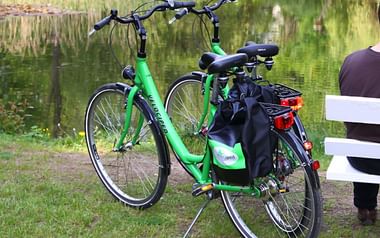
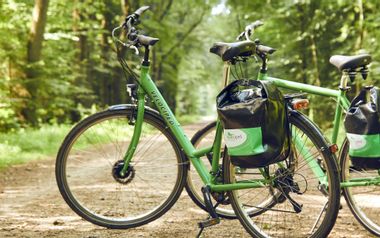
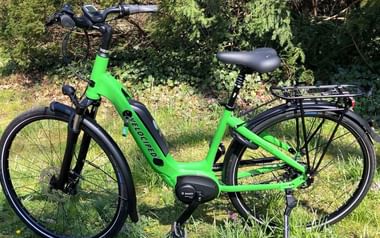

We would recommend the 7-speed tourer for all those that are looking for a back-pedal brake and wide gel seat for maximum comfort in an upright sitting position. It is equipped with a simple hub gear shift and is perfectly suited to tours on flat to slightly hilly terrain.

The 27-speed tourer is the best choice for cyclists that value the advantages of the dérailleur gear shift for flexibility whilst going up and down hills. This bike allows you to be a little more active without compromising on saddle comfort and practical everyday suitability.

E-bikes combine a lot of advantages. The electric drive ensures a completely relaxed cycling, even during long tours or on hilly routes. Other features, such as a suspension seat post and front fork plus well-tuned gears, ensure additional riding comfort.

I provide you with advice and assistance
Siri Nuphim
